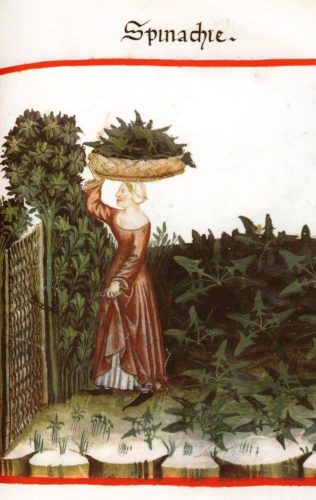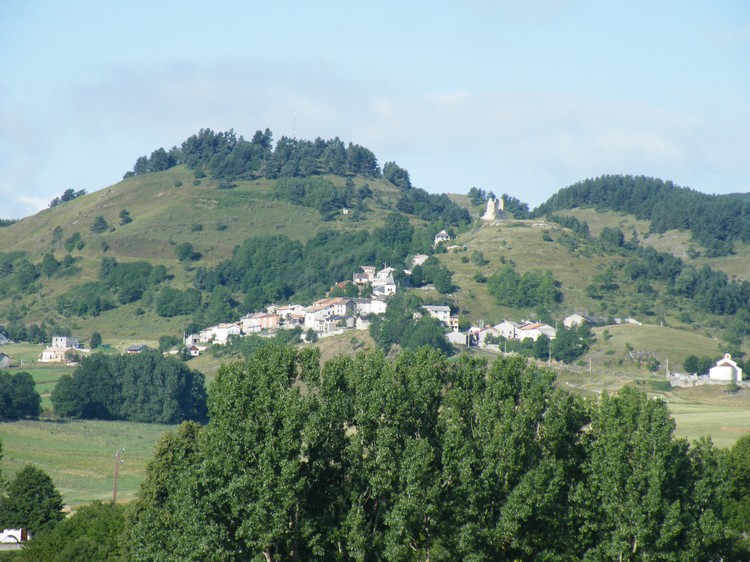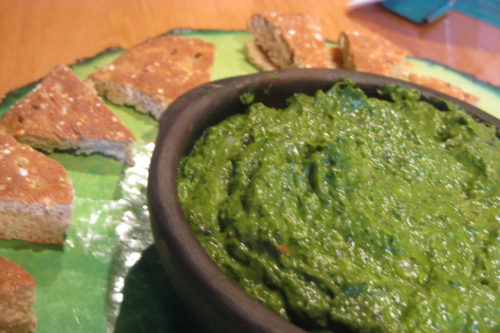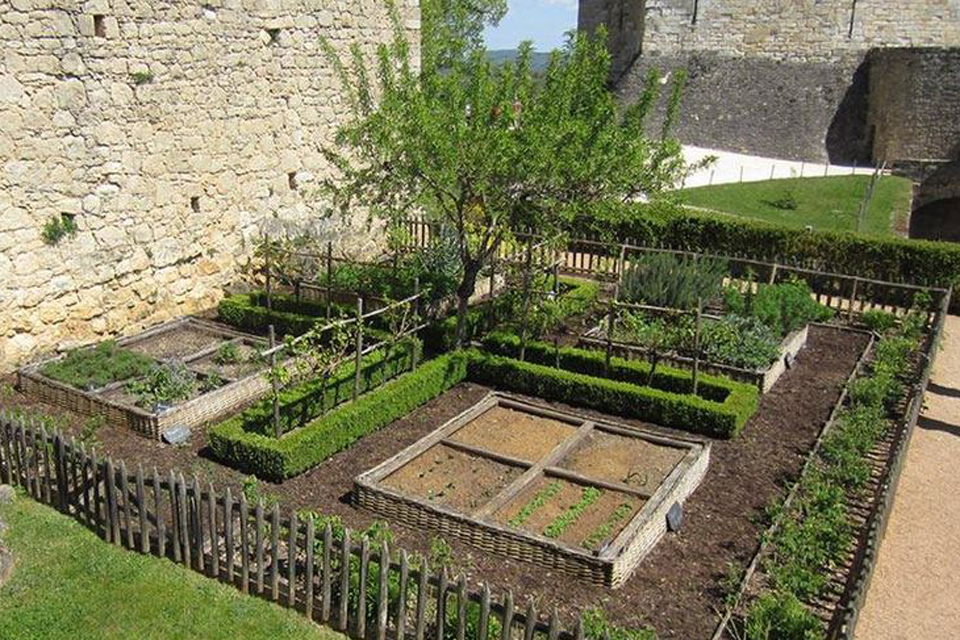Montaillou, famous for its Cathars, was excavated from 1998 – 2004. Charred remains of spinach were found in the hearth and in pits

Spinach is an annual or biennial cultivated plant. The exact origin is not known although the general assumption is, that wild plants in Uzbekistan were the original progenitor. In Europe, however, it is only known as a cultivated plant.
The aim of the present research has been to present the earliest evidence of carbonised fruits and seeds of Spinach in Europe, which were unexpectedly identified in charred remains from the hearth and fills within an abandoned medieval castle, le Castellas de Montaillou (known from the book of Jacques LeGoff: Montaillou).
The castle is located on the Northern Slope of the central Pyrenees in the Départment of Ariège lies 40 km. South-East of Foix. From 1998 to 2006 J.-P Cazes excavated the castle. It was here, in a house dated from the end of the 12th and the beginning of the 13th century, the remains of spinach were found together with other crops and fruits: with oats dominating, hulled barley, naked wheat (durum) and rye together with peas, common vetch, lentils and broad beans, were also found in the samples. To this should be added walnuts, hazelnuts, blackberries, raspberries, strawberries and grapes plus 61 wild plants, some of which might have been used as part of the diet. Finally, the archaeologists found a few remains of hemp and flax .
The evidence from Montaillou points to a terminus ante quem around 1200 – 1230 AD. Until now (2014) 42 archaeobotanical finds of Spinach have been recorded. However, they all date from a later period.
Cultivation of spinach is known to have taken place in ancient Mesopotamia and China. However, neither the ancient Greeks nor the Romans are known to have cultivated the plant. Also, it is absent from the ordinance Capitulare de villis vel curtis from 800 AD. The first European mentioning is found in the 12th century treatise of Kitâb al-Filâha (Book of Agriculture), showing it was cultivated in Spain since at least the 11th century.

From the time of the finds from Montaillou, we possess records from markets, which document that spinach was grown in Catalonia at that point and from there was exported to Perpignan in France. A bit later the plant was described and illustrated in medieval and agronomic treatises. At the same time spinach became included in several European collections of recipes destines for royal or elite families (e.g. Liber de coquina 1306 and Libre de Sent Soví 1324.)
According to Arabic texts, the plant was called the “prince of vegetables”. The authors of the present study, however, raise the question what the commercial and social value was in the rest of Europe? The evidence is not straightforward. Records from 13th century Germany show that it was primarily consumed in urban, wealthy contexts. From the 14th century, evidence points to spinach having been reduced to a common ingredient in soups. It was primarily used in Lenten dishes. By the end of the Middle Ages spinach rose in the hierarchy of vegetables consumed by wealthy Italians and later other Europeans. This development was probably part of the increasingly important part, which vegetables came to play in the diets in early Modern Europe.
“What cause favoured the presence of spinach seeds at Montaillou around 1200, ask Hallavant and Ruas? Where they casually introduced by animals and people? Bought in the markets or acquired as gifts from Muslim Spain? A careful analysis of where the remains were found in the excavated house inside the castle helps to pinpoint the context.
First of all, we are told the remains were found in the house where the cooking and food preparation took place. This house was furthermore the largest house in the village, and the other finds point to the inhabitants as being wealthy. On the other hand, some remains were found in a pit mixed up with goat-dung, pointing to the spinach being fodder residue. Perhaps a shepherd lived in the house in the final phase? The authors speculate. However, they do seem to forget – or at least not mention – that it was common practice to mix ashes with dung to enhance its value as a fertiliser. It seems more probable that a plant, which seeds were exported to be sold in markets at that time, had entered the household of high-status family living in the mountain castrum at the end of the 13th century.
SOURCE:
The first Archaeobotanical evidence of Spinacia oleracea L. (Spinach) in late 12th – mid 13th century A.D. France
By Charlotte Hallavant and Marie-Pierre Ruas
In: Vegetation History & Archaeobotany 2014 Vol.23pp. 153 – 165
Springer Verlag 2013
READ MORE
Montaillou: The promised Land of Error.
By Emmanuel Le Roy Ladurie.
George Braziller Inc.; 30th Anniversary Edition edition 2008. First edition 1978
The Yellow Cross: The Story of the Last Cathars’ Rebellion Against the Inquisition, 1290-1329
By Rene Weis
Penguin 2000
ISBN 0-14-027669-6
Le site castral de Montaillou en Ariège. Résidences aristocratiques, résidences du pouvoir entre Loire et Pyrénées (Xe − XVe siècle).
By J. -P. Cazes
Actes du colloque de Pau (Octobre 2002). Archéologie du Midi Médiéval 2006 suppl 4:325–336
Bergers de Montaillou.
By A. Cazenave
In: Brenon A, Dieulafait C (eds) Autour de Montaillou, village occitan, histoire et religiosité d’une communauté villageoise au Moyen Age. Actes du colloque de Montaillou (Août 2000),
L’Hydre, Castelnaud la Chapelle, pp 185–211
Montaillou, l’occupation aristocratique d’un “castrum” pyrénéen au regard du mobilier archéologique et des restes carpologiques.
By J.-P. Cazes and C. Hallavant C
In: Guillot F (ed) Châteaux pyrénéens au Moyen Âge: naissance, évolutions et fonctions des fortifications médiévales en comté de Foix. Couserans et Comminges, Louve, Cahors, pp 365–384
Le Registre d’inquisition de Jacques Fournier (évêque de Pamiers) 1318 – 1325
Ed. by Duvernoy, Jean and Preface by Le Roy Ladurie, Emmanuel
Series: Civilisations et Sociétés 43
De Gruyter 2012
FEATURED PHOTO
Medieval Garden in Cathar fortress of Castelnaud la Chappelle, Périgord, France © Avantgardens
RECIPES:

The Medieval Spanish Chef presents several recipes for spinach – amongst others a recipe for Cream of Spinach and Almond Soup Recipe, perfect for Lent
Another enticing recipe is a dip, known as Silq Bi-Laban or Chard in Youghurt adapted from the Kitab-Al-Tabikh, a 13th century cook book from the 13th century.
Ingredients:
1/2 dl. olive oil
2 shallots chopped
2 garlic cloves chopped
500 gram spinach (or just plain ground elder, which is all over any garden in spring-time)
1 dl yogurt
2 tsp cinnamon
1 tsp ginger
½ tsp nutmeg
½ tsp freshly ground cloves
salt to taste
pepper to taste
Preparation
Heat a frying pan. Add oil. Add scallions and gently fry until translucent. Add the garlic when scallions begin to become soft. Add spinach and reduce heat. Stir, cover and leave it for another minute or until withered. Chop spinach with scallions and put mixture in a bowl and add yogurt, salt and pepper. Mix well and chill.
Serve as a dip with thin slices of flatbread.



